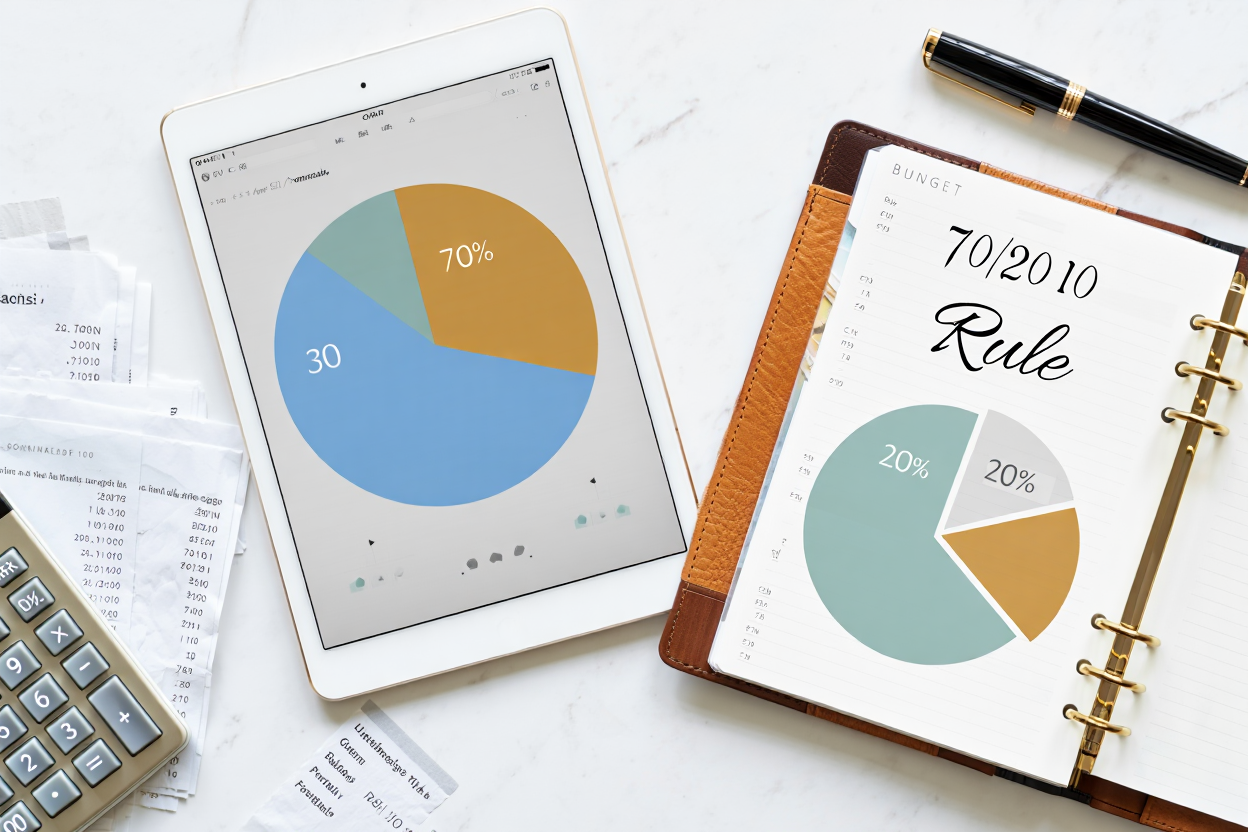
If you’ve ever tried to create a budget and felt overwhelmed by spreadsheets, endless categories, or complicated math, you’re not alone.
Luckily, simple budgeting methods exist — and the 70/20/10 rule is one of the easiest and most effective.
In this guide, we’ll break down exactly how the 70/20/10 budget rule works, why it’s so popular, and how you can start using it today to gain control over your money without the stress.
📚 What Is the 70/20/10 Budget Rule?
At its core, the 70/20/10 budget rule is a simple money management formula:
- 70% of your income goes to spending (living expenses and lifestyle)
- 20% goes to saving (building your future)
- 10% goes to debt repayment or donations (clearing liabilities or giving back)
That’s it.
No complicated apps, no overwhelming categories.
Just three main buckets to focus on.
🧠 Why Does the 70/20/10 Rule Work So Well?
The beauty of the 70/20/10 method lies in its simplicity and flexibility.
It doesn’t tell you exactly how to spend your money — it gives you a structure that fits a wide range of lifestyles.
Here’s why it’s so effective:
- Clear Priorities: It forces you to prioritize savings and debt alongside spending.
- Easy to Stick To: With just three categories, it’s much easier to track compared to detailed budgets.
- Adaptable: You can adjust it slightly based on your goals without losing the structure.
- Fast Setup: You can create a 70/20/10 budget in less than an hour.
📊 Breaking Down Each Section of the 70/20/10 Rule
Let’s dive deeper into each part:
1. 70% for Spending 💸
This is the biggest piece of your budget and covers everything you need to live and enjoy life, including:
- Rent or mortgage
- Utilities (electricity, water, gas)
- Transportation (gas, public transit, car payments)
- Groceries
- Health insurance
- Entertainment (movies, streaming services)
- Dining out
- Clothing
- Hobbies
- Travel
✅ Tip:
Make sure your essential expenses (like housing and food) fit comfortably inside this 70%.
If your essentials alone take up 70%, you might have little left for fun — that’s a sign you may need to downsize or cut back.
2. 20% for Savings 🏦
The second category is about building your financial future.
This 20% should go into:
- Emergency fund
- Retirement accounts (401(k), IRA)
- Investment accounts
- Savings for big goals (house, wedding, business startup)
✅ Tip:
If you don’t have an emergency fund yet (3–6 months’ expenses saved), focus on building that first.
After that, prioritize retirement savings — the earlier you invest, the more your money can grow thanks to compound interest.
3. 10% for Debt Repayment or Donations 💳❤️
The final 10% can go two ways:
- Debt repayment: Student loans, credit card debt, personal loans, medical debt
- Donations: Charity, religious giving, supporting causes you believe in
✅ Tip:
If you have high-interest debt (like credit cards), focus your 10% here first.
Once you’re debt-free, you can redirect the 10% toward giving, saving, or investing more.
🧮 Quick Example of the 70/20/10 Rule in Action
Let’s say your monthly income after taxes is $4,000.
Here’s how the 70/20/10 rule would divide it:
| Category | Amount | Use |
|---|---|---|
| 70% Spending | $2,800 | Rent, bills, groceries, entertainment |
| 20% Saving | $800 | Emergency fund, retirement, investments |
| 10% Debt/Donation | $400 | Student loans, credit cards, or charity |
✨ Pros and Cons of the 70/20/10 Rule
✔️ Pros
- Simple and intuitive — even budgeting beginners can stick to it
- Flexible — works for different income levels
- Prioritizes savings automatically
- Quick setup — no endless spreadsheets
❌ Cons
- Not highly detailed — doesn’t work for micromanagers
- May not fit high-debt situations — if you have major debt, you might need to allocate more than 10%
- Fixed percentages — might not perfectly match everyone’s cost of living (e.g., high-rent cities)
🔥 How to Set Up Your 70/20/10 Budget Step-by-Step
Ready to put it into action? Here’s how:
Step 1: Calculate Your Net Income
Figure out how much money you actually take home after taxes, health insurance, and retirement contributions are deducted from your paycheck.
✅ Example:
If your salary is $60,000 a year, but after deductions you bring home $3,800 per month, use $3,800 — not $5,000 — for your budget.
Step 2: Apply the 70/20/10 Formula
Multiply your net income:
- 70% Spending → Net income × 0.7
- 20% Savings → Net income × 0.2
- 10% Debt/Donations → Net income × 0.1
Step 3: List Your Expenses
Write down all monthly expenses and categorize them.
✅ Pro Tip:
If your spending category is tight, look for ways to cut unnecessary subscriptions or shop smarter.
Step 4: Automate Your Savings and Debt Payments
Set up automatic transfers:
- Automatically move savings to a separate account after payday.
- Automate minimum debt payments or extra payments if possible.
Automation helps you stay consistent without having to think about it.
Step 5: Adjust as Needed
Life changes — and so should your budget!
Review it every few months or after major life events (job change, move, marriage).
📈 When Should You Modify the 70/20/10 Rule?
Sometimes, the basic 70/20/10 split won’t quite fit your situation.
Here’s when you should adjust it:
| Situation | Adjustment Suggestion |
|---|---|
| High debt | Shift 10% from savings to debt payoff |
| Low living costs | Shift more than 20% to savings/investing |
| Starting from scratch savings | Prioritize emergency fund first |
| High cost of living | You might need 75% or more for spending temporarily |
✅ Important:
Budgeting is a tool — not a punishment. Customize it to support your life, not restrict it.
📋 70/20/10 Budget Template [FREE Download]
Want to skip the math?
Here’s a simple 70/20/10 budget template you can use each month:
- Income:
- Net Monthly Income: __________
- Spending (70%):
- Rent: __________
- Utilities: __________
- Groceries: __________
- Transportation: __________
- Fun/Lifestyle: __________
- Savings (20%):
- Emergency Fund: __________
- Retirement: __________
- Investments: __________
- Debt/Donation (10%):
- Debt Payments: __________
- Charitable Giving: __________
(Feel free to download our [fillable version here] — link to your resource!)
🏆 Final Thoughts: Is the 70/20/10 Budget Rule Right for You?
If you want a simple, effective, and low-stress way to manage your money, the 70/20/10 rule is an incredible place to start.
It keeps your finances organized without overwhelming you with complicated tracking systems.
Plus, it balances living well today with building security for tomorrow — which is exactly what smart money management is all about.
🙋♀️ Frequently Asked Questions (FAQ)
What if I have irregular income?
Base your percentages on an average monthly income or your lowest predictable monthly amount. Adjust when you have a surplus.
Can I tweak the percentages?
Absolutely! Think of 70/20/10 as a guideline, not a law. Many people use variations like 60/30/10 or 75/15/10 based on their goals.
Is the 70/20/10 rule better than the 50/30/20 rule?
They are different tools!
- 50/30/20 focuses on needs, wants, and savings.
- 70/20/10 focuses on spending, saving, and debt/giving.
Pick the one that feels most natural for your mindset.
📌 Final Call: Start Your 70/20/10 Budget This Week!
There’s no “perfect time” to get your finances in order — today is the best day to start.
Set up your 70/20/10 budget this week, and take the first step toward financial confidence and freedom!
Take the first step toward smarter, simpler money management today!


